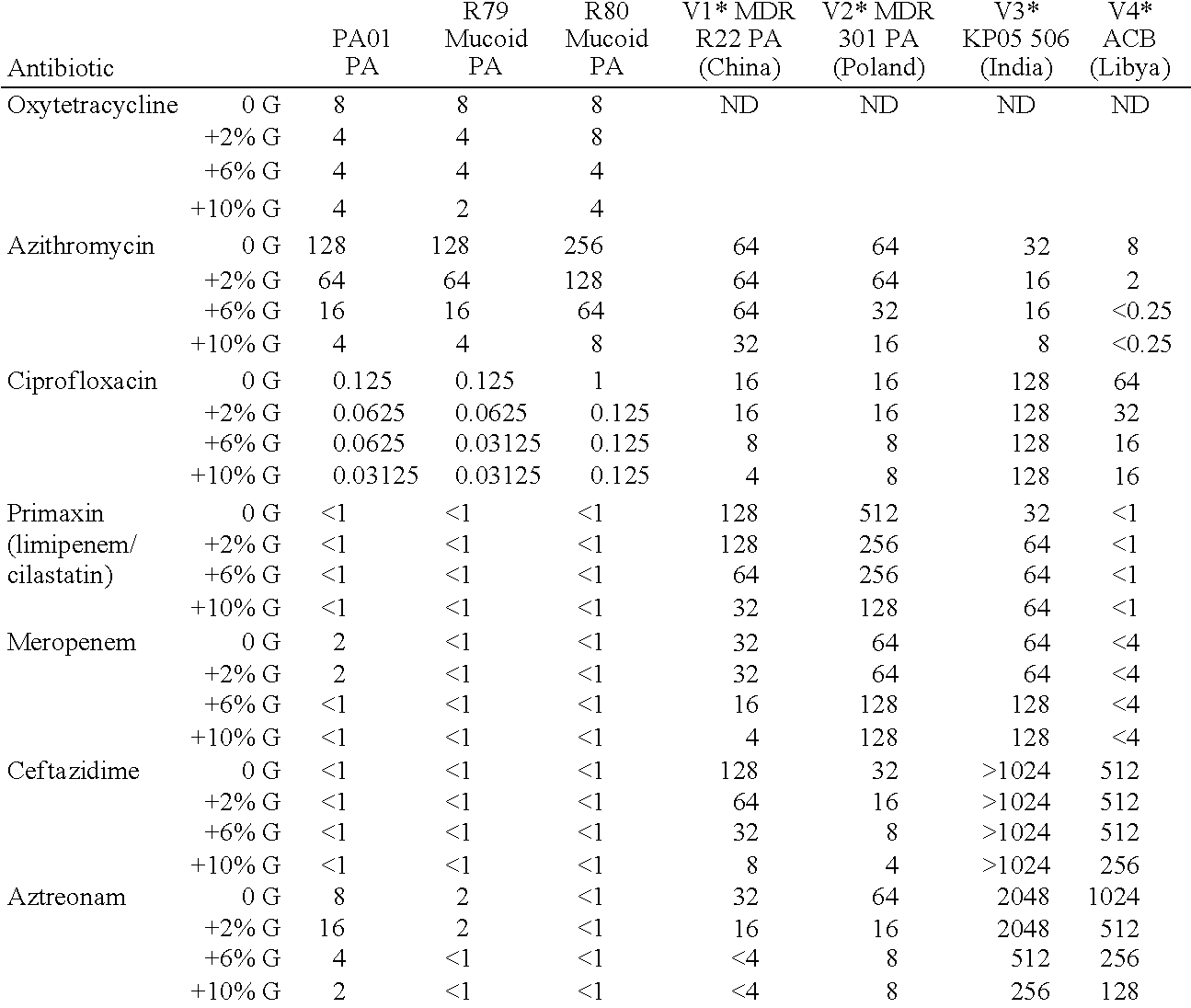Alginate oligomers for use in overcoming multidrug resistance in bacteria
a technology of alginate oligomers and bacteria, which is applied in the field of alginate oligomers, can solve the problems of increasing the problem of esbl-positive i>p. stuartii/i> in hospitalized patients, restricting the number of different antibiotic classes to which resistance is seen, and reducing the sensitivity of the target to the antibiotic, etc., and achieves a high-efficiency approach.
- Summary
- Abstract
- Description
- Claims
- Application Information
AI Technical Summary
Benefits of technology
Problems solved by technology
Method used
Image
Examples
example 1
Effect of G-Block Alginate Oligomers on the Minimum Inhibitory Concentrations of Various Antibiotics for Various Bacterial Strains
Materials and Methods
Bacterial Strains Used:
[0306]PA01 Pseudomonas aeruginosa ATCC 15692[0307]Pseudomonas aeruginosa ATCC 39324, mucoid type strain (R79)*[0308]Pseudomonas aeruginosa CFA 24-1, clinical mucoid strain (R80)*[0309]Pseudomonas aeruginosa MDR R22 from China (V1)*[0310]Pseudomonas aeruginosa MDR 301 from Poland (V2)*[0311]Klebsiella pneumoniae KP05 506 from India (V3)*[0312]Acinetobacter baumannii MDR ACB from Libya (V4)*
[0313]*Non-official labels assigned for internal identification purposes only.
Abbreviations used: Pseudomonas aeruginosa, (PA); Klebsiella pneumoniae (KP); Acinetobacter baumannii (ACB)
Media and Bacterial Strains Used:
[0314]Following retrieval from −80° C. storage, bacterial colonies were grown on blood agar with 5% sheep blood and were used to inoculate tryptone soya broth (TSB) for overnight growth. Antibiotics were diluted i...
example 2
[0324]The study described in Example 1 was repeated with the following strains of bacteria and antibiotics as detailed in Tables 4, 5 and 6.
[0325]Bacterial Strains[0326]PA01 Pseudomonas aeruginosa ATCC 15692 (E77)[0327]R79* Mucoid Pseudomonas aeruginosa ATCC 39324 ISOLATION: sputum from a cystic fibrosis patient, Boston, Mass.[0328]R80* Mucoid Pseudomonas aeruginosa CFA 24-1 (CLINICAL ISOLATE from a CF patient)[0329]V1* R22 PSA (China) Pseudomonas aeruginosa [0330]V2* MDR 301 PSA (Poland) Pseudomonas aeruginosa [0331]V3* KP05 506 (India) Klebsiella pneumoniae [0332]V4* MDR ACB (Libya) Acinetobacter baumannii [0333]V5* AIM-1 E. coli [0334]V9* (Egypt) Acinetobacter baumannii [0335]V10* (Egypt) Acinetobacter lwoffii [0336]V11* 5702 (Wales) E. coli [0337]V12* 5725 (Wales) Klebsiella pneumoniae [0338]V22* 6056 Acinetobacter [0339]V23* 1322 Burkholderia cepacia
*Non-official labels assigned for internal identification purposes only.
TABLE 4Minimum inhibitory concentration (MICs) of differe...
example 3
[0343]The study described in Example 1 was repeated with the following strains of Acinetobacter baumannii, antibiotics and M-block alginate oligomer in place of OligoG CF-5 / 20 as detailed in Table 7. The M-block oligomer is 100% M with a DPn of 15 to 18,
TABLE 7Minimum inhibitory concentration (MICs) of different antibiotics for a strain ofAcinetobacter baumannii displaying an MDR phenotype anda strain of Acinetobacter baumannii displaying an non-MDR phenotypein the presence of varying concentrations of M-block oligomer (0-10%).(MIC values are expressed in μg ml−1).
[0344]The results displayed in Table 7 show that M-block oligomers are, like OligoG CF-5 / 20, also effective in lowering MIC values for a number of different antibiotics (including a macrolide) in MDR and non-MDR strains of Acinetobacter baumannii.
PUM
| Property | Measurement | Unit |
|---|---|---|
| molecular weight | aaaaa | aaaaa |
| molecular weight | aaaaa | aaaaa |
| molecular weight | aaaaa | aaaaa |
Abstract
Description
Claims
Application Information
 Login to View More
Login to View More - R&D
- Intellectual Property
- Life Sciences
- Materials
- Tech Scout
- Unparalleled Data Quality
- Higher Quality Content
- 60% Fewer Hallucinations
Browse by: Latest US Patents, China's latest patents, Technical Efficacy Thesaurus, Application Domain, Technology Topic, Popular Technical Reports.
© 2025 PatSnap. All rights reserved.Legal|Privacy policy|Modern Slavery Act Transparency Statement|Sitemap|About US| Contact US: help@patsnap.com



